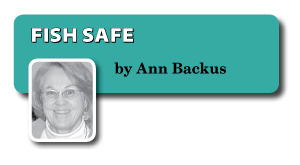by Ann Backus –
It’s been nearly four-and-a-half years since the March 24, 2009 sinking of the Cape May, NJ-based Lady Mary and the loss of six of her seven crewmen. That’s a long time for everyone touched by this tragedy.
But, on Aug. 30, the Coast Guard released the final report on its investigation into the sinking. It includes 43 recommendations stemming directly from problems, errors, and omissions identified during the lengthy probe and offers some sobering lessons for everyone who works on a commercial fishing vessel.

To set the scene, on that March 24, the Lady Mary was entering the seventh day of a trip to the Elephant Trunk area 65 nautical miles southeast of Cape May, and the scalloping had been quite good for the crew. Another fisherman in the area at the time reported that the weather was rough with north/northwest winds of 20 to 30 knots.
José Arias, the sole survivor of the accident, testified that he was asleep in his bunk when another crewman woke him at about 5am and told him the vessel was in trouble. Once outside, Arias saw that about a third of the deck was awash and the Lady Mary was listing about 30° to port.
The report went on to explain that nearby fishing boat crews thought they heard but could not decipher a brief, frantic mayday call, and they received no response to call backs for the vessel’s location. An EPIRB signal was received but, because of a clerical misreading of an “O” for a “C,” the device was not properly registered to the Lady Mary. This caused a delay of more than an hour in launching a Coast Guard helicopter to investigate. The helicopter crew eventually recovered Arias, as well as the captain and a deckhand who did not survive. The bodies of two other crewmen were eventually recovered. One crewman remains missing.
An extensive, labor-intensive investigation followed the sinking, with divers descending to the boat sitting on the bottom in 210′ of water in order to identify and record the damage, which was mostly to the stern, the rudder, and propeller. Marine forensics experts tried to reconstruct how the damage could have happened and why the boat sank so quickly.
Collision ruled out
Extensive speculation in the months following the sinking that the Lady Mary had been run down by a passing container ship was chronicled by Star Ledger journalist Amy Ellis Nutt in a 2010 five-part series that earned her a Pulitzer Prize for feature writing the following year.
However, the Coast Guard’s final report ruled out a collision, concluding that the paths of the fishing vessel and the closest ship could not have intersected.
Instead, in a press release announcing the report, the Coast Guard said the fishing vessel sank due to a combination of “unsafe preconditions and a few unsafe decisions.” And the final report called the incident “survivable.”
So, what went wrong?
The captain wasn’t licensed, nor was he required to be. He had no formal safety training or vessel operations training, only on-the-job training, which, according to the report, did “not produce a competent captain.”
When rescuers finally arrived on scene, Arias was recovered wearing a survival suit. The two other crewmen who were found unresponsive also were wearing survival suits, but both suits were filled with water.
The life raft was found properly inflated and close to the survivor but out of reach.
Training recommendations
When interviewed, Arias said he received some training from the previous captain of the Lady Mary. But, the report noted, “during his time on the Lady Mary, the survivor did not receive training regarding the EPIRB, life raft, first aid, or fishing gear safety. He did not receive any training regarding the bilge pumps either, but he was
familiar with their operation.”
National Marine Fisheries Service observers had gone out on the Lady Mary in 2007, 2008, and 2009, and their logs revealed that, although safety drills were promised and discussed, they were never held.
This lack of competence, training, and drills prompted a number of recommendations in the Coast Guard report. These included: expediting a rulemaking to require individuals in charge of commercial fishing vessels to pass an approved training program; establishing a requirement for all crewmen to pass an approved basic safety training program prior to working on a fishing vessel; and more stringent requirements for recording drills and orientations.
Another major area of concern raised by the investigation was water- and weather-tight integrity. The report noted that while current law “establishes a standard for watertight and weather-tight closures and coamings on all decks and bulkheads exposed to the weather … it doesn’t apply to commercial fishing industry vessels that are less than 79 feet in length.”
At 71′, the Lady Mary fell outside of these vessel integrity requirements. Inspectors found the lazarette cover off because there was no through-hull connection and the crew had been pumping water out of the bilge by running a hose from the bilge to the outside.
Watertight subdivisions in the hold were missing, doors were open or missing, the aft fish hold hatch was not watertight, the forward fish hold hatch had no cover, and the freeing ports were partially blocked, allowing water to accumulate on deck.
The report included at least nine recommendations to address water- and weather-tight integrity. A major one was to add language to current requirements that would apply various vessel integrity standards to all documented vessels fishing beyond 3 nautical miles from the baseline regardless of length.
The investigation also revealed that there were stability and perhaps tonnage issues that may have affected the Lady Mary’s stability. After Nov. 5, 2001, when the boat changed hands, a pilothouse and aft bunk were added to the vessel. No stability analysis was done, but none was required for this size boat.
The report included recommendations to change this situation for shorter boats and to educate captains and crew regarding the hazards of making modifications without conducting follow-up stability assessments.
We’ll discuss some of the other recommendations in future articles. The conclusions of the investigation and the subsequent recommendations are timely given that a number of them may be incorporated into the ongoing rulemaking process to implement changes authorized by the Coast Guard Authorization Act of 2010.
The full report on the investigation into the sinking of the Lady Mary is available online at https://homeport.uscg.mil. Click on “Investigations.”
Ann Backus, MS, is the director of outreach for the Harvard School of Public Health’s Department of Environmental Health in Boston, MA. She may be reached by phone at (617) 432-3327 or by e-mail at <abackus@hsph.harvard.edu>.
<< Back to Fishing Vessel Safety Page







